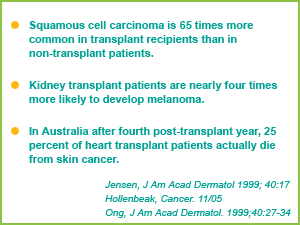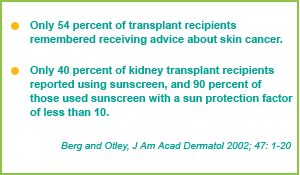 |
| Transplant Patients |
 |
Why Are Solid Organ Transplant Recipients
at Increased Risk? |
 |
| The immunosuppressive medications necessary for the survival of your transplanted organ also increase your risk of skin cancer. |
 |
| While there may be a lag time of five to seven years after transplant surgery before skin cancers begin to develop, this period will vary for each organ recipient depending on individual risk factors. For example, if you are older when you receive your transplant, skin cancers may develop earlier. In addition, the longer you take immunosuppressant medication and the higher the dose, the greater your risk of skin cancer. |
 |
| Am I at Increased Risk? |
 |
All transplant patients, regardless of skin color, are more
susceptible to skin cancer than people without transplants.
However, transplant patients with the following characteristics
are at significantly increased risk for skin cancer: |
- Fair or easily burned skin
- Extensive freckling
- Blue, green or hazel eyes
- Red or blonde hair
- Outdoor occupation or history of extensive sun exposure
- Family history of skin cancer
- Personal history of skin cancer
|
 |
| What Can I Do to Reduce My Risk? |
 |
| Before and after receiving an organ transplant, you should discuss with your medical team the dangers of skin cancer and how to prevent it as you cope with your organ transplant. |
 |
| Following the skin care steps below is a good start toward helping to prevent skin cancer: |
 |
| 1. Practice safe and smart sun protection |
 |
- Apply a broad-spectrum sunscreen, with a high sun protection factor (SPF) of at least 30 that protects against UVA and UVB. (UVA and UVB refer to light rays that are damaging to the skin.)
- Make sunscreen part of your morning routine … brush, shower and sunscreen before you leave the bathroom … everyday!
- Apply sunscreen to all exposed skin, especially the face, neck, back of hands and forearms
- Reapply sunscreen every two hours when outdoors, especially if you are swimming or sweating
- Wear protective, tightly woven clothing, including long-sleeved shirts and pants, sunglasses and a broad-brimmed hat (brims should be at least four inches wide)
- Avoid sun exposure between 10:00 a.m. and 4:00 p.m., when the sun’s rays are the strongest, and plan outdoor activities accordingly
- Avoid commercial tanning booths
- Consider taking 500 units of vitamin D per day
|
 |
| 2. Perform self-skin examinations and see a dermatologist |
|
 |
- Self- skin examination — Examining your skin monthly for precancers and skin cancers can be a lifesaving habit. During a monthly self-skin exam, you should look for any new or changing growths including pink patches or spots, scaly growths, bleeding spots, or changing moles.
- Skin examination by a physician — Your transplant physician should examine your skin during your annual evaluation or refer you to a dermatologist. If you are developing precancers or are a high-risk patient, then a regular full skin examination by a dermatologist can be helpful. A full skin examination involves a review of the entire surface of your skin. A dermatologist may be able to notice suspicious growths and spots before they become apparent to you. High-risk patients may need to be followed by a dermatologist as often as every one to two months for optimal care.
|
 |
| 3. Seek early treatment |
 |
| If you notice a new, changing or suspicious growth during your self-skin examination, contact a dermatologist or a member of your transplant team to receive prompt evaluation. |
 |
| 4. Use preventative medications |
 |
| For patients who are at high risk of developing skin cancer, various preventative strategies, including creams, skin treatments and oral medications, can be employed to reverse precancers or lessen the risk of cancer development. Your dermatologist can discuss these with you. |
 |
| How Is Skin Cancer Treated? |
 |
| If caught early, skin cancer is almost always curable. |
 |
| Basal cell carcinomas and squamous cell carcinomas can be treated with a variety of methods including creams or scraping and freezing for early skin cancers, and surgical removal for more advanced cancers. Mohs micrographic surgery is a special surgical procedure used to assure the complete removal of a skin cancer, while sparing normal skin. |
 |
| For high-risk transplant patients, skin cancer can become a severe problem. Repeated surgeries for skin cancer can significantly decrease the quality of life due to significant scarring, sometimes affecting appearance. When skin cancer severely affects an organ transplant patient, immunosuppressant medications may be reduced or changed and preventative medications, such as retinoids, may be administered. |
 |
| You are the Key! |
 |
| Understanding that you are at increased risk for skin cancer, using effective sun protection methods, knowing how to recognize possible skin cancers, and seeking prompt treatment can literally save your life. |
 |









